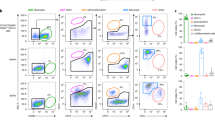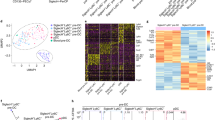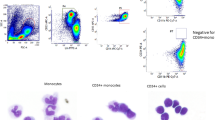Abstract
Dendritic cells (DCs) are the most potent antigen-presenting cells responsible for the initiation of primary immune responses, playing a key role in eliciting effective antitumor immune responses. We reported previously that leukemic blasts from selected patients with acute myeloid leukemia (AML) were able to differentiate in vitro into cells with DC features. In order to identify genes differentially expressed in leukemia-derived DCs (AML-DCs), a polymerase chain reaction (PCR)-based subtraction approach was applied using cDNA from AML-DCs and monocyte-derived DCs from healthy donors as competitors. In the 548 sequences analyzed, 80% corresponded to fibronectin (FN) gene fragments. Overexpression of FN in AML-DCs was demonstrated both by semiquantitative PCR analysis and by immunostaining. In addition, we could show that FN was secreted by AML-DCs. Indeed, FN overexpression was already detectable in AML blasts of M4 and M5 subtype, and was significantly induced during DC differentiation after culture. Although the molecular events leading to overexpression of FN and the in vivo relevance of this phenomenon remain to be resolved, leukemic DCs appear to have specific patterns of differentiation, warranting stringent biological and cellular monitoring for the development and testing of leukemic DC-based immunotherapeutic strategies.
This is a preview of subscription content, access via your institution
Access options
Subscribe to this journal
Receive 12 print issues and online access
$259.00 per year
only $21.58 per issue
Buy this article
- Purchase on Springer Link
- Instant access to full article PDF
Prices may be subject to local taxes which are calculated during checkout






Similar content being viewed by others
References
Banchereau J, Steinman RM . Dendritic cells and the control of immunity. Nature 1998; 392: 245–252.
Caux C, Dezutter-Dambuyant C, Schmitt D, Banchereau J . GM-CSF and TNF-alpha cooperate in the generation of dendritic Langerhans cells. Nature 1992; 360: 258–261.
Sallusto F, Lanzavecchia A . Efficient presentation of soluble antigen by cultured human dendritic cells is maintained by granulocyte/macrophage colony-stimulating factor plus interleukin 4 and downregulated by tumor necrosis factor alpha. J Exp Med 1994; 179: 1109–1118.
Charbonnier A, Gaugler B, Sainty D, Lafage-Pochitaloff M, Olive D . Human acute myeloblastic leukemia cells differentiate in vitro into mature dendritic cells and induce the differentiation of cytotoxic T cells against autologous leukemias (in process citation). Eur J Immunol 1999; 29: 2567–2578.
Mohty M, Isnardon D, Blaise D, Mozziconacci MJ, Lafage-Pochitaloff M, Briere F et al. Identification of precursors of leukemic dendritic cells differentiated from patients with acute myeloid leukemia. Leukemia 2002; 16: 2267–2274.
Choudhury BA, Liang JC, Thomas EK, Flores-Romo L, Xie QS, Agusala K et al. Dendritic cells derived in vitro from acute myelogenous leukemia cells stimulate autologous, antileukemic T-cell responses. Blood 1999; 93: 780–786.
Harrison BD, Adams JA, Briggs M, Brereton ML, Yin JA . Stimulation of autologous proliferative and cytotoxic T-cell responses by ‘leukemic dendritic cells’ derived from blast cells in acute myeloid leukemia. Blood 2001; 97: 2764–2771.
Mutis T, Verdijk R, Schrama E, Esendam B, Brand A, Goulmy E . Feasibility of immunotherapy of relapsed leukemia with ex vivo-generated cytotoxic T lymphocytes specific for hematopoietic system-restricted minor histocompatibility antigens. Blood 1999; 93: 2336–2341.
ten Bosch GJ, Toornvliet AC, Friede T, Melief CJ, Leeksma OC . Recognition of peptides corresponding to the joining region of p210BCR-ABL protein by human T cells. Leukemia 1995; 9: 1344–1348.
Molldrem J, Dermime S, Parker K, Jiang YZ, Mavroudis D, Hensel N et al. Targeted T-cell therapy for human leukemia: cytotoxic T lymphocytes specific for a peptide derived from proteinase 3 preferentially lyse human myeloid leukemia cells. Blood 1996; 88: 2450–2457.
Molldrem JJ, Lee PP, Wang C, Felio K, Kantarjian HM, Champlin RE et al. Evidence that specific T lymphocytes may participate in the elimination of chronic myelogenous leukemia. Nat Med 2000; 6: 1018–1023.
van Baren N, Chambost H, Ferrant A, Michaux L, Ikeda H, Millard I et al. PRAME, a gene encoding an antigen recognized on a human melanoma by cytolytic T cells, is expressed in acute leukaemia cells. Br J Haematol 1998; 102: 1376–1379.
Inoue K, Ogawa H, Sonoda Y, Kimura T, Sakabe H, Oka Y et al. Aberrant overexpression of the Wilms tumor gene (WT1) in human leukemia. Blood 1997; 89: 1405–1412.
Bennett JM, Catovsky D, Daniel MT, Flandrin G, Galton DA, Gralnick HR et al. Proposed revised criteria for the classification of acute myeloid leukemia. A report of the French–American–British Cooperative Group. Ann Intern Med 1985; 103: 620–625.
Chomczynnski PSN . Single-step method of RNA isolation by acid guanidium thiocyanate-PhOH-chloroform extraction. Anal Biochem 1987; 162: 156–159.
Hubank M, Schatz DG . cDNA representational difference analysis: a sensitive and flexible method for identification of differentially expressed genes. Methods Enzymol 1999; 303: 325–349.
Lucas S, De Smet C, Arden KC, Viars CS, Lethe B, Lurquin C et al. Identification of a new MAGE gene with tumor-specific expression by representational difference analysis. Cancer Res 1998; 58: 743–752.
Weynants P, Lethe B, Brasseur F, Marchand M, Boon T . Expression of image genes by non-small-cell lung carcinomas. Int J Cancer 1994; 56: 826–829.
Matsui Y, Nakata K, Araki N, Ozono K, Fujita Y, Tsumaki N et al. Alternative splicing of fibronectin transcripts in osteochondrogenic tumors. Anticancer Res 2001; 21: 1103–1106.
De Smet C, Lurquin C, van der Bruggen P, De Plaen E, Brasseur F, Boon T . Sequence and expression pattern of the human MAGE2 gene. Immunogenetics 1994; 39: 121–129.
Mohty M, Jarrossay D, Lafage-Pochitaloff M, Zandotti C, Briere F, de Lamballeri XN et al. Circulating blood dendritic cells from myeloid leukemia patients display quantitative and cytogenetic abnormalities as well as functional impairment. Blood 2001; 98: 3750–3756.
Ahn JH, Lee Y, Jeon C, Lee SJ, Lee BH, Choi KD et al. Identification of the genes differentially expressed in human dendritic cell subsets by cDNA subtraction and microarray analysis. Blood 2002; 100: 1742–1754.
Hashimoto S, Suzuki T, Dong HY, Nagai S, Yamazaki N, Matsushima K . Serial analysis of gene expression in human monocyte-derived dendritic cells. Blood 1999; 94: 845–852.
Wilson HL, O'Neill HC . Identification of differentially expressed genes representing dendritic cell precursors and their progeny. Blood 2003; 102: 1661–1669.
Koukoulis GK, Howeedy AA, Korhonen M, Virtanen I, Gould VE . Distribution of tenascin, cellular fibronectins and integrins in the normal, hyperplastic and neoplastic breast. J Submicrosc Cytol Pathol 1993; 25: 285–295.
Oyama F, Hirohashi S, Shimosato Y, Titani K, Sekiguchi K . Oncodevelopmental regulation of the alternative splicing of fibronectin pre-messenger RNA in human lung tissues. Cancer Res 1990; 50: 1075–1078.
Oyama F, Hirohashi S, Sakamoto M, Titani K, Sekiguchi K . Coordinate oncodevelopmental modulation of alternative splicing of fibronectin pre-messenger RNA at ED-A, ED-B, and CS1 regions in human liver tumors. Cancer Res 1993; 53: 2005–2011.
Midulla M, Verma R, Pignatelli M, Ritter MA, Courtenay-Luck NS, George AJ . Source of oncofetal ED-B-containing fibronectin: implications of production by both tumor and endothelial cells. Cancer Res 2000; 60: 164–169.
Giancotti FG, Ruoslahti E . Integrin signaling. Science 1999; 285: 1028–1032.
Hynes RO . Integrins: versatility, modulation, and signaling in cell adhesion. Cell 1992; 69: 11–25.
Yamada KM . Fibronectin peptides in cell migration and wound repair. J Clin Invest 2000; 105: 1507–1509.
Clark EA, Golub TR, Lander ES, Hynes RO . Genomic analysis of metastasis reveals an essential role for RhoC. Nature 2000; 406: 532–535.
Bittner M, Meltzer P, Chen Y, Jiang Y, Seftor E, Hendrix M et al. Molecular classification of cutaneous malignant melanoma by gene expression profiling. Nature 2000; 406: 536–540.
Zhang L, Zhou W, Velculescu VE, Kern SE, Hruban RH, Hamilton SR et al. Gene expression profiles in normal and cancer cells. Science 1997; 276: 1268–1272.
Ohnishi T, Hiraga S, Izumoto S, Matsumura H, Kanemura Y, Arita N et al. Role of fibronectin-stimulated tumor cell migration in glioma invasion in vivo: clinical significance of fibronectin and fibronectin receptor expressed in human glioma tissues. Clin Exp Metastasis 1998; 16: 729–741.
Ioachim E, Charchanti A, Briasoulis E, Karavasilis V, Tsanou H, Arvanitis DL et al. Immunohistochemical expression of extracellular matrix components tenascin, fibronectin, collagen type IV and laminin in breast cancer: their prognostic value and role in tumour invasion and progression. Eur J Cancer 2002; 38: 2362–2370.
Verfaillie CM, McCarthy JB, McGlave PB . Differentiation of primitive human multipotent hematopoietic progenitors into single lineage clonogenic progenitors is accompanied by alterations in their interaction with fibronectin. J Exp Med 1991; 174: 693–703.
Hurley RW, McCarthy JB, Verfaillie CM . Direct adhesion to bone marrow stroma via fibronectin receptors inhibits hematopoietic progenitor proliferation. J Clin Invest 1995; 96: 511–519.
Bonnet D, Dick JE . Human acute myeloid leukemia is organized as a hierarchy that originates from a primitive hematopoietic cell. Nat Med 1997; 3: 730–737.
Fialkow PJ, Singer JW, Raskind WH, Adamson JW, Jacobson RJ, Bernstein ID et al. Clonal development, stem-cell differentiation, and clinical remissions in acute nonlymphocytic leukemia. N Engl J Med 1987; 317: 468–473.
Randolph GJ, Beaulieu S, Lebecque S, Steinman RM, Muller WA . Differentiation of monocytes into dendritic cells in a model of transendothelial trafficking. Science 1998; 282: 480–483.
Matsunaga T, Takemoto N, Sato T, Takimoto R, Tanaka I, Fujimi A et al. Interaction between leukemic-cell VLA-4 and stromal fibronectin is a decisive factor for minimal residual disease of acute myelogenous leukemia. Nat Med 2003; 9: 1158–1165.
de la Fuente MT, Casanova B, Garcia-Gila M, Silva A, Garcia-Pardo A . Fibronectin interaction with alpha4beta1 integrin prevents apoptosis in B cell chronic lymphocytic leukemia: correlation with Bcl-2 and Bax. Leukemia 1999; 13: 266–274.
Yoshida H, Nishiura T, Karasuno T, Matsumura I, Ishikawa J, Yoshimura M et al. Effect of the interaction between fibronectin and VLA-4 on the proliferation of human B cells, especially a novel human B-cell line, OPM-3. Br J Haematol 1998; 103: 804–812.
Bendall LJ, Makrynikola V, Hutchinson A, Bianchi AC, Bradstock KF, Gottlieb DJ . Stem cell factor enhances the adhesion of AML cells to fibronectin and augments fibronectin-mediated anti-apoptotic and proliferative signals. Leukemia 1998; 12: 1375–1382.
Hocevar BA, Brown TL, Howe PH . TGF-beta induces fibronectin synthesis through a c-Jun N-terminal kinase-dependent, Smad4-independent pathway. EMBO J 1999; 18: 1345–1356.
Mohty M, Olive D, Gaugler B . Leukemic dendritic cells: potential for therapy and insights towards immune escape by leukemic blasts. Leukemia 2002; 16: 2197–2204.
Jonuleit H, Schmitt E, Schuler G, Knop J, Enk AH . Induction of interleukin 10-producing, nonproliferating CD4(+) T cells with regulatory properties by repetitive stimulation with allogeneic immature human dendritic cells. J Exp Med 2000; 192: 1213–1222.
Dhodapkar MV, Steinman RM . Antigen-bearing immature dendritic cells induce peptide-specific CD8(+) regulatory T cells in vivo in humans. Blood 2002; 100: 174–177.
Author information
Authors and Affiliations
Corresponding author
Additional information
AVC was supported by a grant from the ‘Ligue Nationale contre le Cancer (France)’.
Rights and permissions
About this article
Cite this article
Vialle-Castellano, A., Gaugler, B., Mohty, M. et al. Abundant expression of fibronectin is a major feature of leukemic dendritic cells differentiated from patients with acute myeloid leukemia. Leukemia 18, 426–433 (2004). https://doi.org/10.1038/sj.leu.2403273
Received:
Accepted:
Published:
Issue Date:
DOI: https://doi.org/10.1038/sj.leu.2403273
Keywords
This article is cited by
-
Gene expression profiles of the normal myometrium after 48 and 96 hours of exposure to BPA
BioChip Journal (2015)
-
Gene expression analysis of uterine smooth muscle cells exposed to bisphenol A
Toxicology and Environmental Health Sciences (2014)
-
Sex differences in the GSK3β-mediated survival of adherent leukemic progenitors
Oncogene (2012)
-
Proinflammatory response of human leukemic cells to dsRNA transfection linked to activation of dendritic cells
Leukemia (2007)
-
Expression of novel markers of pancreatic ductal adenocarcinoma in pancreatic nonductal neoplasms: additional evidence of different genetic pathways
Modern Pathology (2005)



